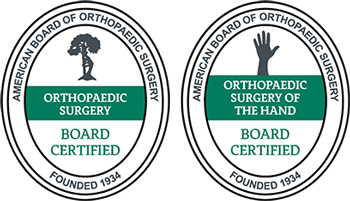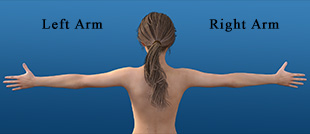Common Hand and Wrist Injuries in the Kitchen
 With Thanksgiving wrapping up and the Holiday Season fast approaching, hand and wrist injuries in the kitchen are at an annual high. While minor cuts and burns may be most common, constant chopping, lifting, and stirring can place heightened strain on the wrist, causing or aggravating injuries such as carpal tunnel or tendonitis. Fortunately, there’s steps you can take – in the kitchen or with a doctor – to prevent and treat these injuries.
With Thanksgiving wrapping up and the Holiday Season fast approaching, hand and wrist injuries in the kitchen are at an annual high. While minor cuts and burns may be most common, constant chopping, lifting, and stirring can place heightened strain on the wrist, causing or aggravating injuries such as carpal tunnel or tendonitis. Fortunately, there’s steps you can take – in the kitchen or with a doctor – to prevent and treat these injuries.
Contents
Common Hand and Wrist Injuries in the Kitchen
Cuts
Cuts are commonplace in the kitchen – from a small nick to the amputation of a digit. While many are minor and can be treated at home, larger cuts should be brought straight to the emergency room – particularly if you can’t stop bleeding, movement or sensation in the finger is lost, or if any part of the hand is accidentally amputated. In the last case, gently clean the amputated part as much as possible, cover it in a moistened gauze wrap, place it in a watertight bag, and put it on ice. Never place the amputated piece in direct contact with ice, as this can cause more damage.
If you have accidentally amputated a part of your hand, a surgeon may be able to reattach the severed piece through replantation. Laceration of specific hand and wrist structures – e.g., tendons, nerves, or arteries – may require reconstructive wrist surgery.
Burns
From the stove to the oven to boiling liquid, burn hazards abound in the kitchen. Luckily, most burns are mild and won’t require a trip to the doctors. However, severe burns can be debilitating and painful and should be treated as soon and as thoroughly as possible to avoid further complications.
There are four classifications of burns, based on the extent of the damage. First-degree burns can be quite sore or tender with a dry redness, while second-degree burns may be white, pink, or red with blisters. While the latter is the most painful of all four types, first- and second-degree burns can be treated at home, typically by submersing the affected area in cool water for ten minutes.
Third-degree burns present with leathery, charred skin and little to no pain (as the nerve endings which sense pain have been burned off), while fourth-degree burns may have visibly exposed muscle or bone, as well as digit loss. Both of these more severe burns require immediate medical care and likely surgery – the area will need repeat cleaning and skin grafts to replace damaged or missing skin. See the burn treatment page for more information.
Tendinitis
Overuse or repetitive actions of a joint – such as dicing vegetables or typing – can inflame tendons, causing pain and soreness, particularly with movement. Also known as tendinitis, these symptoms should be controlled as soon and as thoroughly as possible, since long-term inflammation raises the risk for further injury including rupture of the tendon itself.
A medical provider will first recommend rest for the affected tendon, sometimes with a splint or brace. For the first few days after pain begins, ice is recommended to reduce pain and swelling. Later, heat may be used to increase blood flow to the tendon and encourage healing. Should a rupture occur, reconstructive wrist surgery is usually required.
A very common injury, particularly with age, tendinitis goes by many names depending on the location: tennis elbow, golfer’s elbow, and mommy’s thumb, to name a few.
Carpal Tunnel
The most overt symptoms of carpal tunnel syndrome overlap with tendonitis – pain with movement and swelling. However, instead of tendon inflammation causing pain, carpal tunnel occurs when pressure is placed on a nerve in the wrist by swollen tissues surrounding the nerve.
Due to its association with a nerve, carpal tunnel syndrome can also present with numbness or tingling in the palm or hands, as well as with a loss of fine motor skills with the finger.
Unfortunately, as with tendinitis, the condition can be exacerbated by everyday tasks like texting or typing, making it difficult to treat. Early treatment of the two conditions can be similar, consisting first of rest and bracing as well as cold and warm compresses. However, for moderate to severe carpal tunnel symptomology, surgery is recommended. The procedure involves cutting a ligament within the wrist to relieve pressure on the nerve, and advances have reduced recovery times to one week with minimal scarring and just a 1 cm incision.
Other Possible Injuries
Given the wide variety of cooking techniques and tasks, there are many hand and wrist injuries possible in the kitchen. While the above list covers some of the most common, it is not comprehensive.
If you need assistance determining your potential condition, use the free Where Does it Hurt?® interactive tool. The Where Does it Hurt?® tool will ask you to select your symptoms and provide potential conditions you may be experiencing.
Prevention in the Kitchen
For all chefs, regardless of skill level and ability, the American Society of Hand Therapists has published tips and tricks for preventing injuries in the kitchen:
- Use easy-to-grip versions of common kitchen instruments, and scissors to open bags instead of your thumbs. When faced with a choice, always opt for oversized handles rather than narrow/standard on a tool or go with adaptive equipment designed for hands and wrists with arthritis.
- Use good posture – the nerves in your hands and wrists begin in the neck, meaning that proper alignment above the shoulders will protect you from injury further down the arms. Moreover, shoulders should be kept down to reduce strain on the neck, shoulder, and arm muscles/nerves.
- Slide heavy pots and pans instead of lifting.
- Mitt-style potholders can facilitate proper hand positioning while moving heavy, hot items – a common time for injury. Flat potholders can be more difficult to maneuver and require awkward hand and wrist position.
- Be conscious of where you keep knives and other sharp equipment, particularly if submerged in soapy water.
- Use lightweight dishes and tools whenever possible.
- Don’t overstrain yourself opening jars. Try breaking the seal on a tight lid by tapping on the countertop or running it under warm water.
- When possible, stretch your wrists and arms.
- General kitchen safety should always be practiced: Never cut toward yourself, keep your off-hand fingers curled when chopping on a cutting board, and practice active caution whenever holding a knife.
Citations
- Brubacher, J. W. and Jennings, C. D. (July 2016). Fingertip Injuries and Amputations. Retrieved from https://orthoinfo.aaos.org/en/diseases–conditions/fingertip-injuries-and-amputations/
- Vorvick, L. J. (June 28, 2018). Tendinitis. Retrieved from https://medlineplus.gov/ency/article/001229.htm
- Laskowski, E. R. (September 7, 2017). Tendinitis pain: Should I apply ice or heat? Retrieved from https://www.mayoclinic.org/diseases-conditions/tendinitis/expert-answers/tendinitis/faq-20057872
- Berman, K. (May 24, 2018). Burns. Retrieved from https://medlineplus.gov/ency/article/000030.htm
- Ma, B. (April 21, 2019). Carpal tunnel syndrome. Retrieved from https://medlineplus.gov/ency/article/000433.htm
- Hand Safety and Injury Prevention (n.d.). Retrieved from https://www.asht.org/patients/education-resources/safety-prevention
- Ma, B. (August 15, 2018). Amputated finger. Retrieved from https://medlineplus.gov/ency/imagepages/9821.htm

























